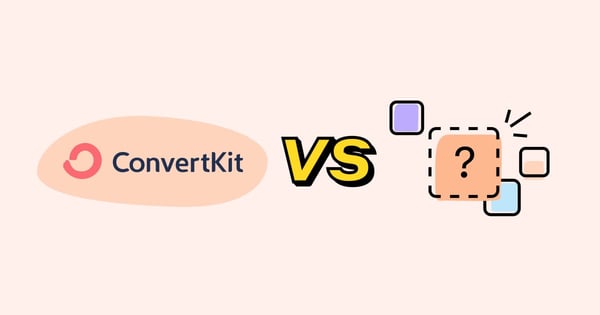ConvertKit isn’t your average email marketing platform.
It caters to a specific niche: content creators who want to reach, engage, and build their audiences through email newsletters. So if you’re a coach, an author, a podcaster, a musician, or any other type of content creator, ConvertKit feels like an obvious fit.
But just because it’s obvious, that doesn’t mean it’s the right choice.
There are tons of ConvertKit alternatives out there; all-rounders and niche tools that offer cheaper prices and/or more comprehensive feature sets.
To help you find the best email marketing platform for your needs, we’ve collated 10 of the best ConvertKit alternatives and compared them across the following criteria:
- Price
- Product features
- Customer support
- Pros and cons
- Target audience
Let’s get into it…
What Are the Best ConvertKit Alternatives?
| ConvertKit Alternatives | Best For | Top Features | Pricing/Month |
| Drip | DTC ecommerce | Segment your whole audience based on real-time store, visitor, and marketing data. | From $39 per month for up to 2,500 contacts and unlimited email sends. |
| Klaviyo | Ecommerce agencies and developers | Personalization and segmentation tools allow you to create customer segments based on real-time data. | Free for up to 250 contacts and 500 monthly email sends; paid plans priced from $20 per month for up to 500 contacts and 5,000 monthly email sends. |
| Mailchimp | Small businesses | Advanced analytics and reporting help marketers make data-driven decisions. | Free for up to 500 contacts and 1,000 monthly email sends; paid plans start at $13 per month for 500 contacts and 5,000 monthly email sends. |
| GetResponse | Small businesses that need advanced marketing tools | Built-in GPT-3.5 powered email generator. | Free for up to 500 contacts and 2,500 monthly email sends. Paid plans start at $13.30 per month for 1,000 contacts and unlimited email sends. |
| Brevo (FKA Sendinblue) | Low-budget email marketing | Send transactional emails with guaranteed 97 percent deliverability. | Free for unlimited contacts and up to 300 emails per day. Paid plans start at $25 per month for unlimited contacts and 20,000 emails per month. |
| Omnisend | Ecommerce marketers | Web push notifications allow brands to instantly retarget customers. | Free to reach up to 250 contacts per month, including 500 monthly email sends, up to 60 SMS messages, and up to 500 web push notifications. Paid plans start at $16 per month to reach up to 500 contacts (including unlimited push notifications). |
| ActiveCampaign | Advanced marketers who need high-level automation | Predictive actions use machine learning to deliver customer experiences based on data, such as the best time to send emails. | From $29 per month for one user and unlimited emails. |
| AWeber | Startups and small businesses | Create email templates in seconds using your website or Facebook page URL. | Free for up to 500 email subscribers and 3,000 monthly email sends; paid plans priced from $16.15 per month for up to 2,500 subscribers. |
| Constant Contact | Nonprofits and charities | Manage campaigns on the go from a dedicated mobile app. | From $12 per month for up to 500 contacts and 5,000 monthly email sends. |
| HubSpot | B2B inbound marketing | Connect marketing, sales, content management, and customer service in a single platform. | Free marketing plan includes unlimited contacts and 2,000 monthly email sends. Paid marketing plans start at $18 per month for 1,000 contacts and 5,000 monthly sends. |

The 10 Best ConvertKit Alternatives:
1. Drip
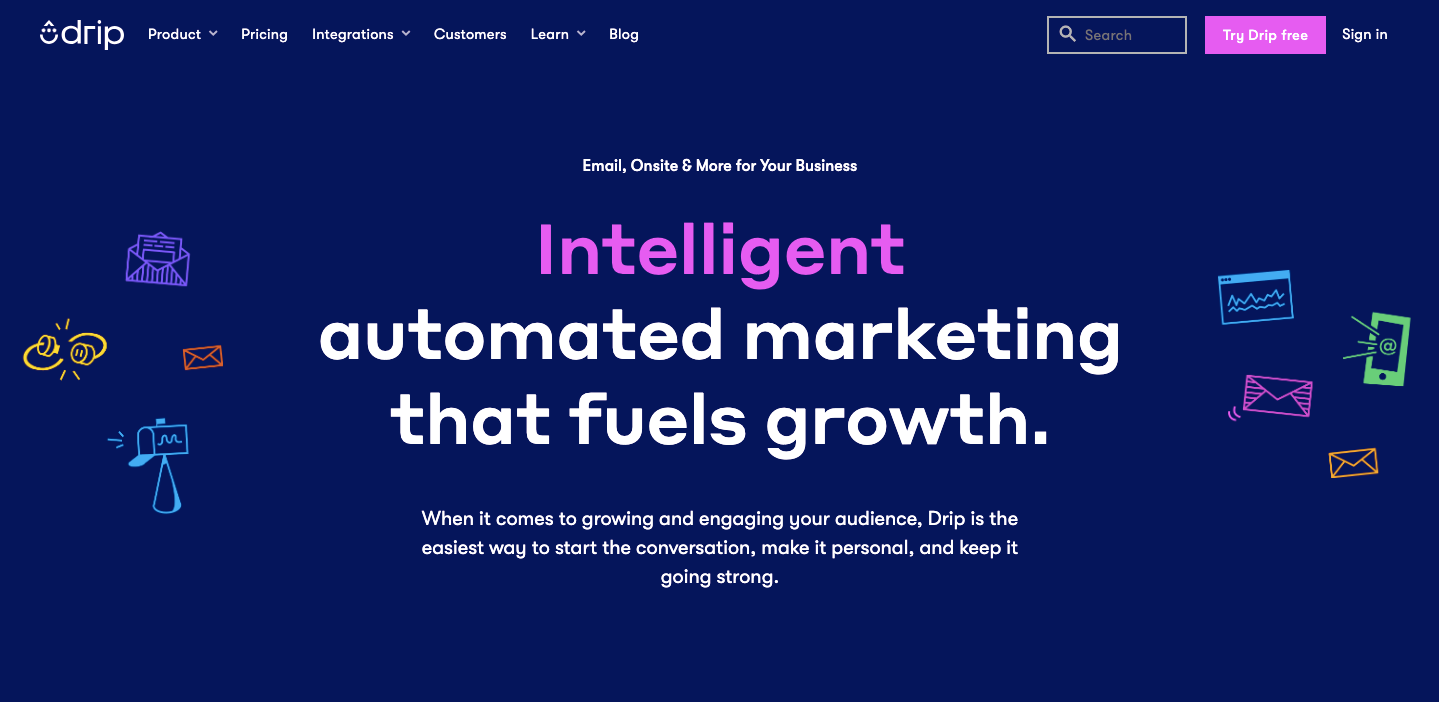 Forgive us for starting on home turf…
Forgive us for starting on home turf…
Drip is our thing. We’re a marketing automation platform built for ecommerce brands and those selling experiences and services. So not technically content creators. But here’s the thing: if you’re trying to sell something—anything—to your audience, our ecommerce functionality could give you the edge.
What Makes Drip the Best ConvertKit Alternative?
- Advanced ecommerce tools. ConvertKit offers basic ecommerce functionality for creators looking to sell digital products. But what about merch? Physical albums? Or anything else non-digital? That’s not an issue with Drip, which is designed to help you promote any type of product (within reason). Plus we integrate with all the major ecommerce platforms (ConvertKit doesn’t).
- Craft ultra-personalized messaging with dynamic segmentation. ConvertKit’s segmentation tools are pretty limited because they’re based on static elements like location and custom form fields. On the flip side, Drip offers dynamic segmentation. Our segments update in real time, so your website visitors will be automatically added to relevant segments based on their actions (like viewing a specific product page or reaching a certain spending threshold).
- Enterprise-grade customer support (at startup prices). However much you pay us, our customer support team will pull up a metaphorical chair and provide personalized recommendations to help you smash your email marketing goals. With ConvertKit, priority live chat and email support is only offered to top-tier Creator Pro-level subscribers.
- Cheaper premium features. ConvertKit has a fantastic free tier, whereas we don’t offer any free functionality beyond a 14-day trial. However, once you outgrow the free plan, ConvertKit gets expensive, fast. For instance, if you’ve got 5,000 subscribers, you’ll have to pay $93/month for Creator Pro (vs. $89 for Drip), and you still won’t get any of our advanced ecommerce features.
- Integrate with more tools. Drip integrates with 150+ other tools, including all the major ecommerce platforms—BigCommerce, Shopify, and WooCommerce. ConvertKit currently has approximately 120 integrations (and doesn’t integrate with BigCommerce).
How Does Drip Compare to ConvertKit?
| Drip | ConvertKit | |
| Best Feature | Segment your whole audience based on real-time store, visitor, and marketing data. | Integrated newsletter referral program helps creators grow their reach by leveraging their existing audience. |
| Best For | DTC ecommerce | Content creators |
| Pros | All customers get access to advanced automations and segmentation, no matter how much you pay. | Fantastic free-for-life plan offering tons of functionality. |
| Cons | No free plan (although we do have a 14-day free trial). | Basic segmentation and personalization features, even at higher tiers. |
| Pricing/Month | From $39 per month for up to 2,500 contacts and unlimited email sends. | Free for up to 1,000 subscribers and unlimited email sends; paid plans start at $9 per month for up to 300 subscribers and unlimited emails. |
| Support | Our support is rated 8.8 on G2 (vs. an average of 8.6 for marketing automation platforms) and includes live audio screen sharing to solve problems in real time. | Paying customers get live chat and email support, with priority access offered to Creator Pro subscribers. Free subscribers only get community support. |
2. Klaviyo
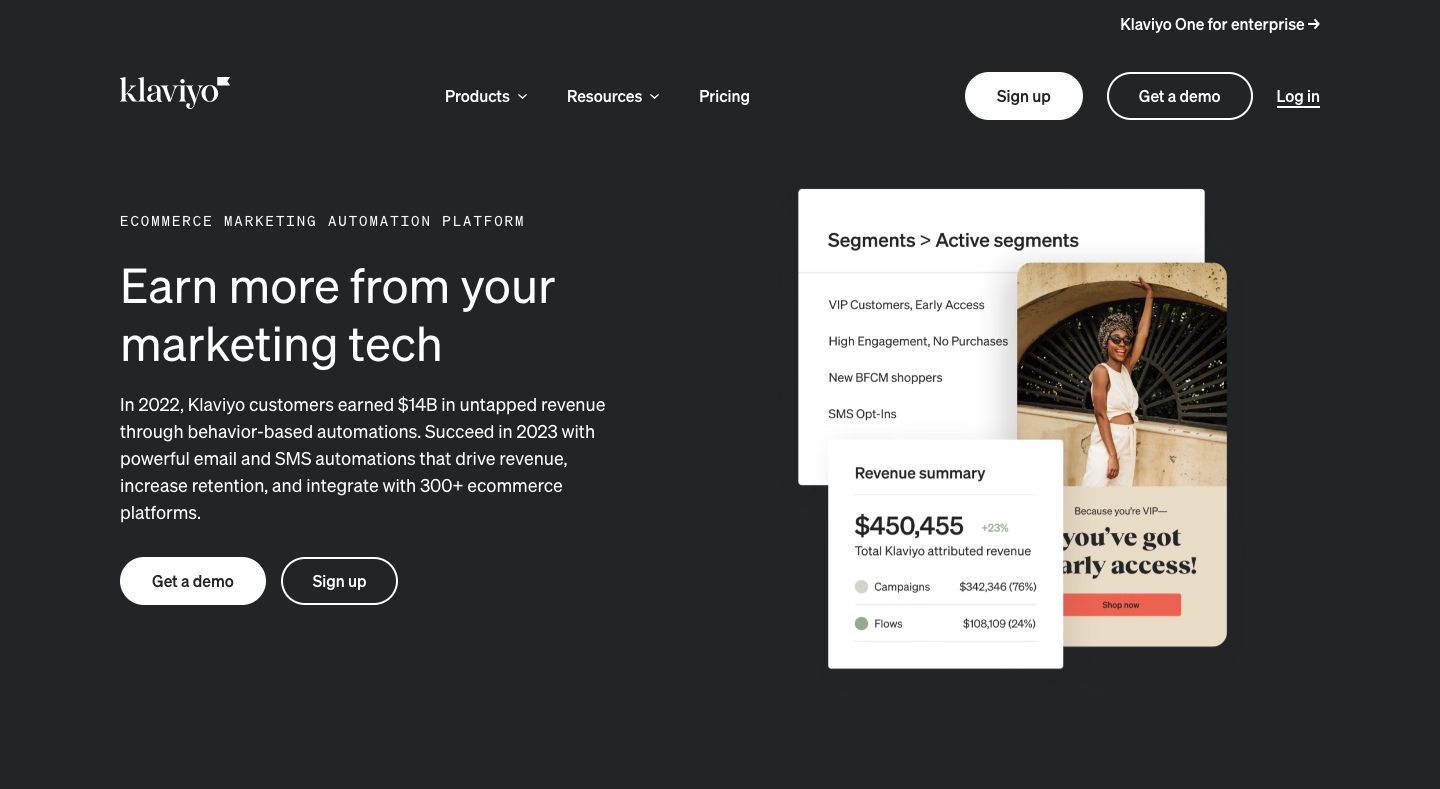 Klaviyo is another sophisticated, ecommerce-friendly email and marketing automation platform. It differs from Drip because it requires access to advanced technical skills to fully leverage its features, meaning it’s best suited to brands with in-house dev teams or an external full-service agency partner. At first glance, Klaviyo isn’t a natural fit for content creators, but let’s see how it stacks up against ConvertKit…
Klaviyo is another sophisticated, ecommerce-friendly email and marketing automation platform. It differs from Drip because it requires access to advanced technical skills to fully leverage its features, meaning it’s best suited to brands with in-house dev teams or an external full-service agency partner. At first glance, Klaviyo isn’t a natural fit for content creators, but let’s see how it stacks up against ConvertKit…
What Makes Klaviyo the Best ConvertKit Alternative?
- Predict your customers’ next move. Klaviyo’s predictive analytics allow you to—guess what?—predict when individual customers will perform certain actions, such as placing an order or churning. You won’t find anything like that at ConvertKit.
- Advanced reporting and analytics. ConvertKit’s reporting is pretty limited; if you need to know much more than how many people opened or clicked-through from your email broadcasts, you’ll be disappointed. Klaviyo, meanwhile, offers a wealth of revenue-focused reporting and analytics tools. Plus it’ll pull in lifetime store data alongside data from other platforms, like customer review and loyalty software.
- Sophisticated A/B testing. Again, ConvertKit offers limited A/B testing; you can only test two subject line variants against one another. And that’s it. With Klaviyo, you can split-test CTA styles, body content, send times, and more besides.
- More generous paid plans. ConvertKit’s free plan blows Klaviyo’s out of the water. But if you have more than 1,000 subscribers, you’ll have to upgrade to a paid plan—and those plans generally offer poorer value for money than Klaviyo’s (albeit you may need to factor in the cost of a full-service agency to take full advantage of Klaviyo).
How Does Klaviyo Compare to ConvertKit?
| Klaviyo | ConvertKit | |
| Best Feature | Personalization and segmentation tools allow you to create customer segments based on real-time data. | Integrated newsletter referral program helps creators grow their reach by leveraging their existing audience. |
| Best For | Ecommerce agencies and developers | Content creators |
| Pros | More sophisticated analytics, reporting, and testing. | Far more generous paid plan. |
| Cons | Requires advanced technical skills to use it properly. | Limited tools for testing and measuring email performance. |
| Pricing/Month | Free for up to 250 contacts and 500 monthly email sends; paid plans priced from $20 per month for up to 500 contacts and 5,000 monthly email sends. | Free for up to 1,000 subscribers and unlimited email sends; paid plans start at $9 per month for up to 300 subscribers and unlimited sends. |
| Support | After the extensive onboarding program, support is limited to live chat and emails. | Paying customers get live chat and email support, with priority access offered to Creator Pro subscribers. Free subscribers only get community support. |
3. Mailchimp
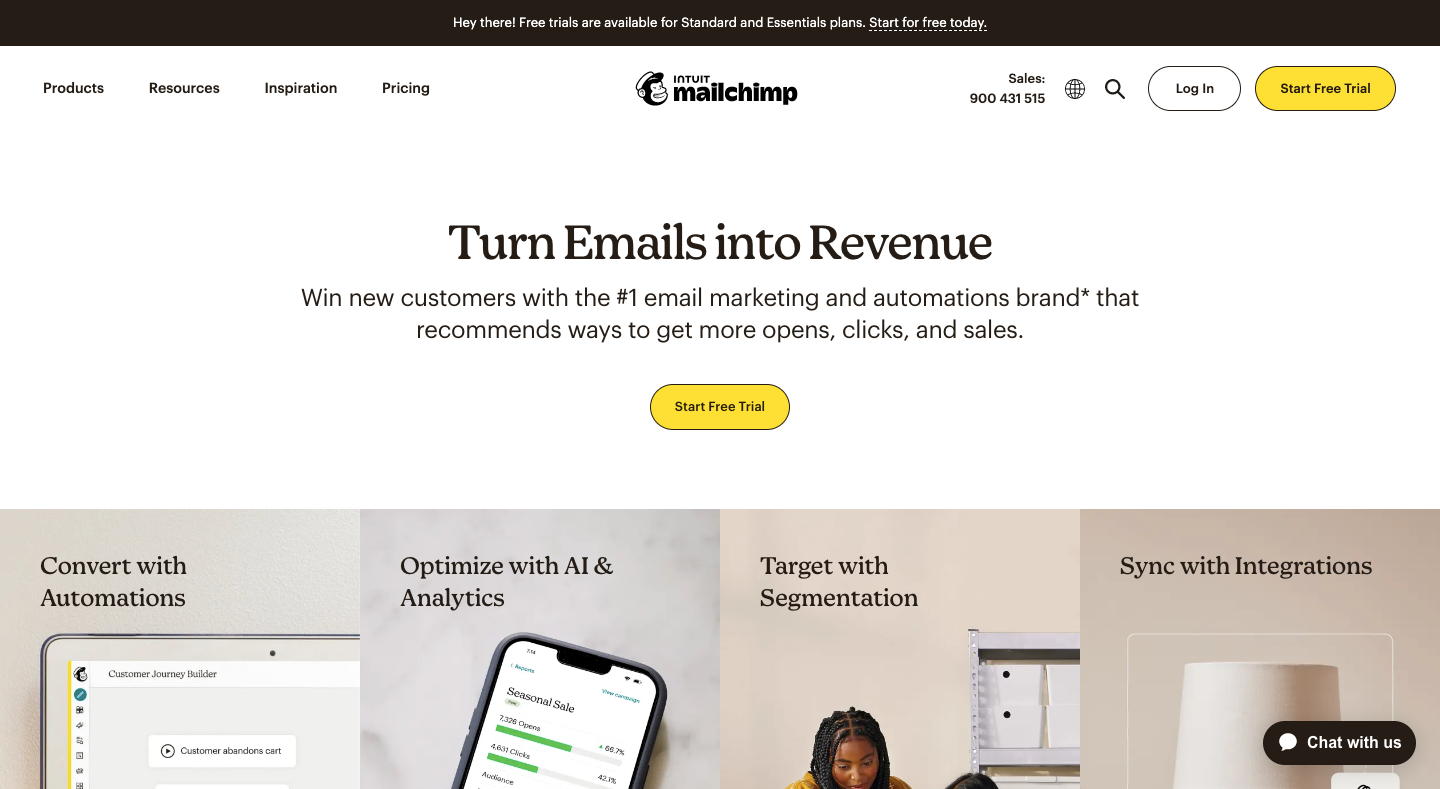 Mailchimp is the first name most people think of when it comes to email marketing. It has a huge customer base, thanks in part to its all-round functionality; everyone from individuals to startups to enterprise-level organizations can benefit from Mailchimp’s tools. But is it really the best alternative to ConvertKit?
Mailchimp is the first name most people think of when it comes to email marketing. It has a huge customer base, thanks in part to its all-round functionality; everyone from individuals to startups to enterprise-level organizations can benefit from Mailchimp’s tools. But is it really the best alternative to ConvertKit?
What Makes Mailchimp the Best ConvertKit Alternative?
- Sophisticated email design testing. Mailchimp offers (limited) access to email testing tool Inbox Preview in all its free plans, allowing users to see how their designs look across different devices and clients. ConvertKit, on the other hand, doesn’t offer any built-in email testing.
- Advanced reporting tools. This one barely seems like a fair comparison. Mailchimp offers some of the most sophisticated reporting functionality on the market, whereas ConvertKit’s analytics tools are limited to basic email engagement metrics.
- More integration options. Mailchimp integrates with over 300 external apps, tools, and platforms, whereas ConvertKit “only” has about 120. Sure, there aren’t too many obvious omissions from ConvertKit’s integrations library, but this is ultimately a numbers game—and Mailchimp is the clear winner.
- Engage your audience through more channels. Mailchimp offers built-in social media management, allowing you to post to Facebook, Instagram, and Twitter—and track the results—without leaving the platform. ConvertKit doesn’t do any of that.
- AI-powered ideation. Mailchimp’s GPT-3 AI tool can generate subject lines, headlines, body copy, and more at the click of a button. At time of writing, ConvertKit doesn’t offer any generative AI capabilities.
How Does Mailchimp Compare to ConvertKit?
| Mailchimp | ConvertKit | |
| Best Feature | Advanced analytics and reporting help marketers make data-driven decisions. | Integrated newsletter referral program helps creators grow their reach by leveraging their existing audience. |
| Best For | Small businesses | Content creators |
| Pros | Better email design testing and analytics. | Offers more landing page templates and a (far) more generous free plan. |
| Cons | Less-generous free plan; lacks ConvertKit’s built-in newsletter referral and monetization tools. | No built-in social media management; limited reporting functionality. |
| Pricing/Month | Free for up to 500 contacts and 1,000 monthly email sends; paid plans start at $13 per month for 500 contacts and 5,000 monthly email sends. | Free for up to 1,000 subscribers and unlimited email sends; paid plans start at $9 per month for up to 300 subscribers and unlimited sends. |
| Support | Paid plans include 24/7 support via chat and email. Phone and priority support is only available to Premium customers paying $350+ per month. | Paying customers get live chat and email support, with priority access offered to Creator Pro subscribers. Free subscribers only get community support. |
4. GetResponse
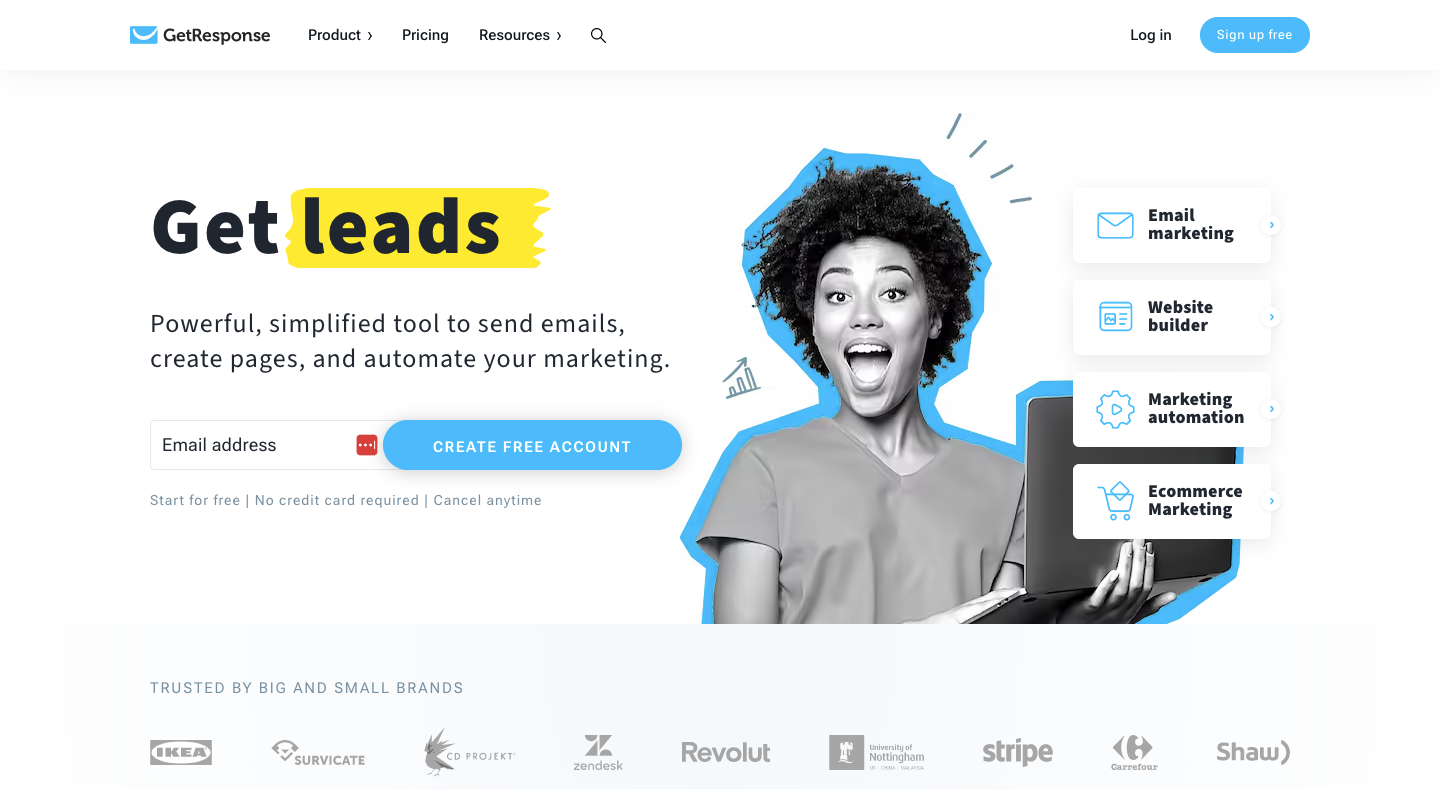 GetResponse is another big-name all-round platform, helping everyone from solopreneurs to global brands like Ikea and Red Bull engage their audiences through email marketing. Customers use it to send approximately 765 million emails every single week.
GetResponse is another big-name all-round platform, helping everyone from solopreneurs to global brands like Ikea and Red Bull engage their audiences through email marketing. Customers use it to send approximately 765 million emails every single week.
What Makes GetResponse the Best ConvertKit Alternative?
- Cheaper email marketing. You might start to notice a repeating theme here: ConvertKit’s free plan is more generous than GetResponse’s. But once you upgrade to higher tiers, ConvertKit struggles to compete. For instance, for $44/month, GetResponse lets you send unlimited emails to up to 5,000 contacts. That’ll cost you a cool $66 from ConvertKit.
- In-platform website builder. ConvertKit’s landing page tools are pretty solid (and available free of charge). But GetResponse customers can leverage an entire website builder—even on the platform’s free plan.
- AI email generator. GetResponse is another marketing automation platform to hop on the generative AI bandwagon, allowing users to quickly craft subject line and body content using nothing more than a simple prompt. ConvertKit doesn’t currently offer this (although you can always get ChatGPT to do it for you, of course).
- Host webinars within the platform. This is a pretty niche use case, but potentially useful nonetheless: with GetResponse, you get built-in webinar hosting. ConvertKit doesn’t do this as standard, although it does integrate with several webinar tools (including Crowdcast and WebinarJam).
How Does GetResponse Compare to ConvertKit?
| GetResponse | ConvertKit | |
| Best Feature | Built-in GPT-3.5-powered email generator. | Integrated newsletter referral program helps creators grow their reach by leveraging their existing audience. |
| Best For | Small businesses that need advanced marketing tools | Content creators |
| Pros | Far better value at higher price plans. | Even the free plan includes unlimited email sends. |
| Cons | Can’t match ConvertKit’s free plan | More limited website creation tools; no AI functionality (yet). |
| Pricing/Month | Free for up to 500 contacts and 2,500 monthly email sends. Paid plans start at $13.30 per month for 1,000 contacts and unlimited email sends. | Free for up to 1,000 subscribers and unlimited email sends; paid plans start at $9 per month for up to 300 subscribers and unlimited sends. |
| Support | Paid plans include 24/7 support via chat and email. Phone support is only available at top-tier MAX2 level; some MAX2 customers can also access Slack support. | Paying customers get live chat and email support, with priority access offered to Creator Pro subscribers. Free subscribers only get community support. |
5. Brevo (FKA Sendinblue)
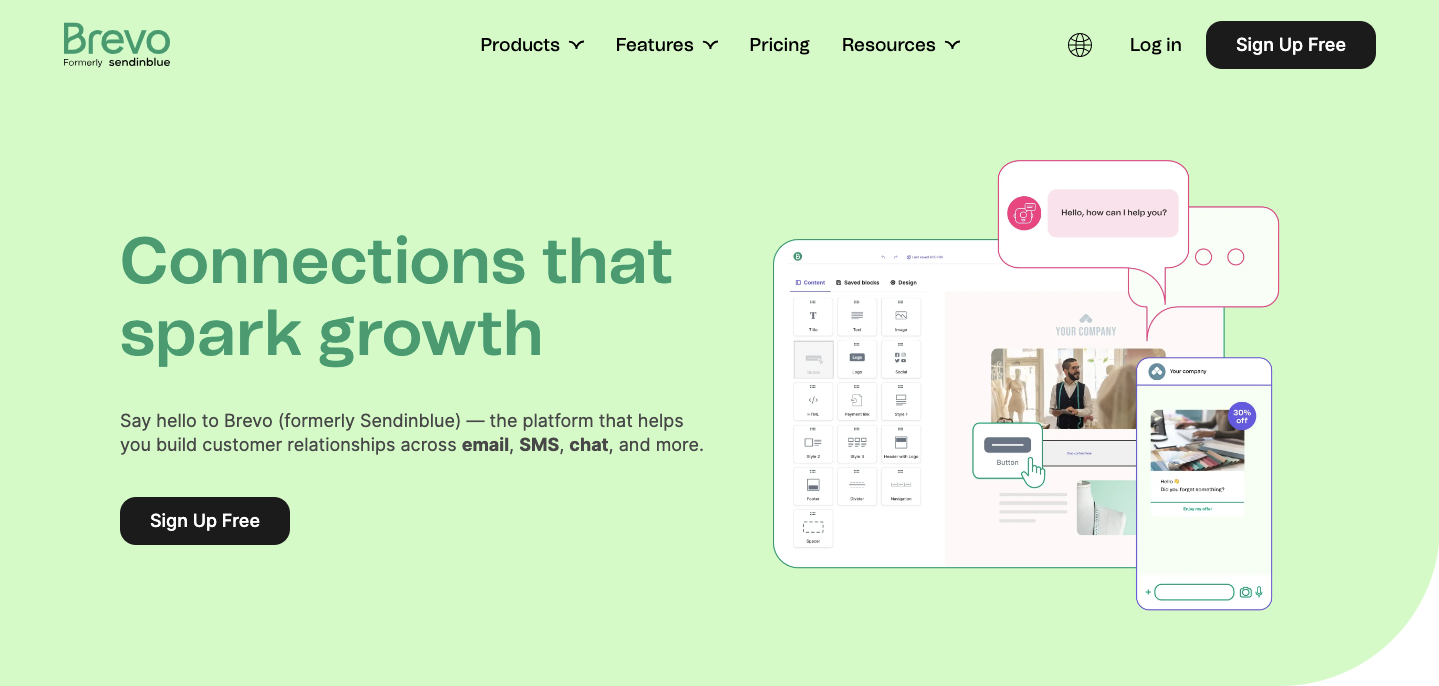 If Brevo sounds unfamiliar, that’s because it used to be called Sendinblue. Whatever the name, it’s a low-cost—yet highly sophisticated—marketing automation platform used by over 500,000 businesses across 180 countries.
If Brevo sounds unfamiliar, that’s because it used to be called Sendinblue. Whatever the name, it’s a low-cost—yet highly sophisticated—marketing automation platform used by over 500,000 businesses across 180 countries.
What Makes Brevo the Best ConvertKit Alternative?
- Target unlimited contacts for free. Finally, we’ve come across a free plan that competes with—and, arguably, outshines—ConvertKit’s. Brevo lets you send up to 300 emails a day to unlimited contacts, all without spending a cent. That’s incredible value.
- Cheaper for large list sizes. Because all Brevo plans include unlimited contacts, it’s a fantastic choice for brands and content creators with large marketing lists. With ConvertKit, the costs add up fast when you exceed 1,000 contacts.
- Bolt-on SMS marketing. With Brevo, you can add SMS marketing to any plan on a low-cost, pay-as-you-go basis. For instance, you can send 1,000 SMS messages to customers in the US for just $10.90. You’ll need an integration with a third-party tool like Textiful to run SMS campaigns through ConvertKit.
- Send transactional emails. Brevo’s plans offer inclusive transactional emails—vital for ecommerce, and also for things like password resets. ConvertKit doesn’t do transactional emails, so again, you’ll need to integrate with an external tool (and you’ll have to pay for the privilege).
- Advanced reporting. As we’ve already noted, ConvertKit’s reporting is pretty basic. Brevo’s is far more sophisticated, offering device and domain-based data, conversion tracking, and even heat mapping for email clicks.
How Does Brevo Compare to ConvertKit?
| Brevo | ConvertKit | |
| Best Feature | Send transactional emails with guaranteed 97 percent deliverability. | Integrated newsletter referral program helps creators grow their reach by leveraging their existing audience. |
| Best For | Low-budget email marketing | Content creators |
| Pros | More generous free plan and cheaper prices for brands and creators with large marketing lists. | Cheaper for sending high email volumes to small marketing lists. |
| Cons | Doesn’t include unlimited emails with any plan. | No transactional emails and limited reporting capabilities. |
| Pricing/Month | Free for unlimited contacts and up to 300 emails per day. Paid plans start at $25 per month for unlimited contacts and 20,000 emails per month. | Free for up to 1,000 subscribers and unlimited email sends; paid plans start at $9 per month for up to 300 subscribers and unlimited sends. |
| Support | The $25+ per month Starter plan only offers email-based support. To receive personalized support, you’ll need to subscribe to an Enterprise plan. | Paying customers get live chat and email support, with priority access offered to Creator Pro subscribers. Free subscribers only get community support. |
6. Omnisend
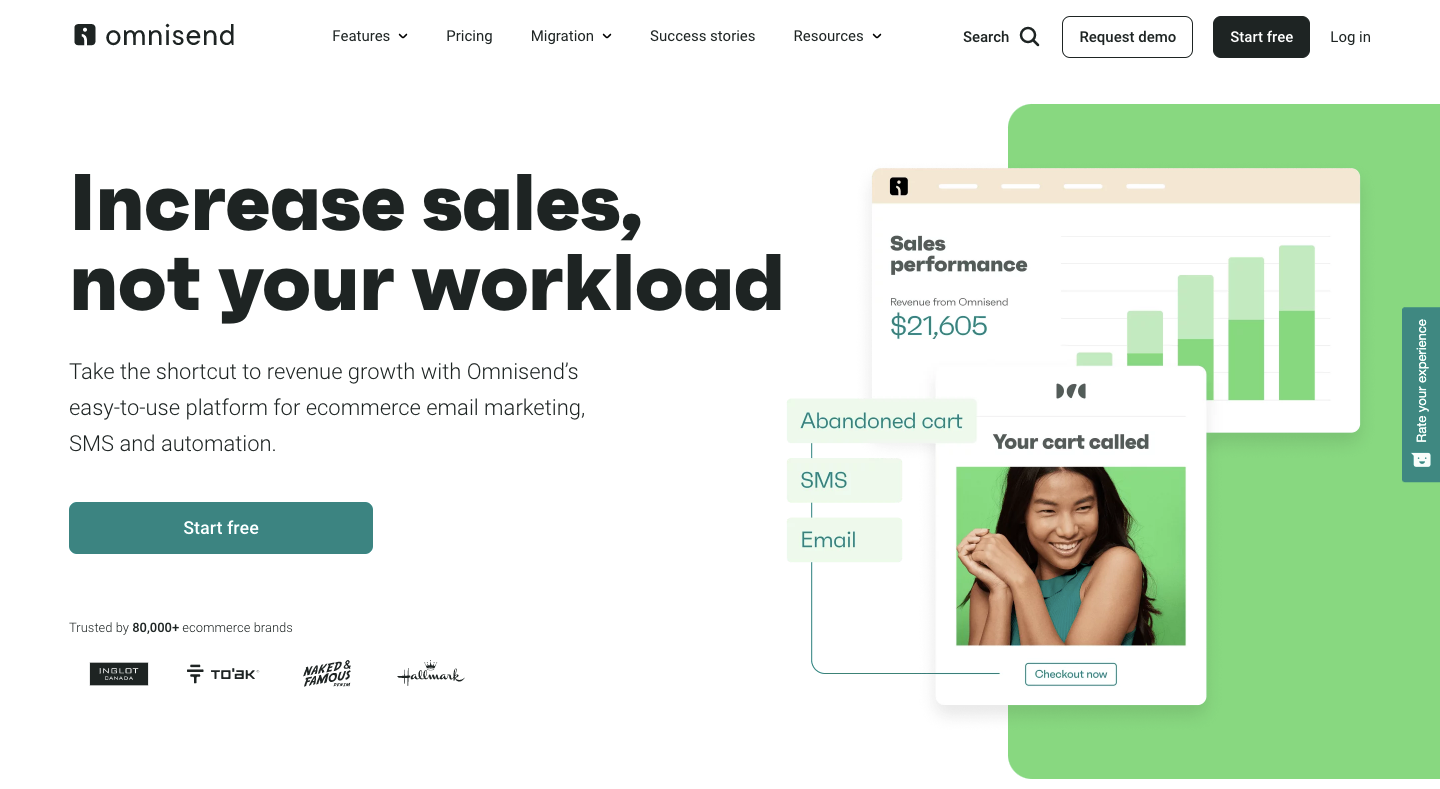 Omnisend—like Drip and Klaviyo—is a marketing automation platform built predominantly for ecommerce brands. But as we’ve already seen, that doesn’t automatically mean it’s a poor fit for content creators. More than 100,000 businesses use Omnisend to engage and convert their audiences through email and SMS campaigns.
Omnisend—like Drip and Klaviyo—is a marketing automation platform built predominantly for ecommerce brands. But as we’ve already seen, that doesn’t automatically mean it’s a poor fit for content creators. More than 100,000 businesses use Omnisend to engage and convert their audiences through email and SMS campaigns.
What Makes Omnisend the Best ConvertKit Alternative?
- Run SMS & push notification campaigns. With Omnisend, you can target customers through SMS messages and push notifications—even on the free product tier. You’ll need a third-party integration to run SMS or push campaigns through ConvertKit.
- Free marketing automation. To be clear, ConvertKit’s free plan is more generous than Omnisend’s. However, it doesn’t offer any marketing automation functionality, whereas all Omnisend customers can access the platform’s pre-built automations and workflows.
- Better value for larger list sizes. As we’ve already noted, ConvertKit gets pretty expensive when you get beyond the 1,000-subscriber free tier. For instance, Omnisend charges $1/month less for 3,000 contacts—as well as offering a ton of extra functionality, like SMS and push campaigns.
- Actionable reporting. Omnisend’s reports give you access to a world of data, helping you identify workflows with the highest open rates, campaigns generating the most revenue, top-performing segments, and much more besides. ConvertKit’s reporting suite is far more basic; it’s pretty much limited to email engagement metrics.
How Does Omnisend Compare to ConvertKit?
| Omnisend | ConvertKit | |
| Best Feature | Web push notifications allow brands to instantly retarget customers. | Integrated newsletter referral program helps creators grow their reach by leveraging their existing audience. |
| Best For | Ecommerce marketers | Content creators |
| Pros | Far more sophisticated reporting; built-in SMS and push campaigns. | Built-in newsletter monetization and audience growth tools. |
| Cons | No content creator-specific features (like built-in referral marketing). | Only offers limited ecommerce functionality. |
| Pricing/Month | Free to reach up to 250 contacts per month, including 500 monthly email sends, up to 60 SMS messages, and up to 500 web push notifications. Paid plans start at $16 per month to reach up to 500 contacts (including unlimited push notifications). | Free for up to 1,000 subscribers and unlimited email sends; paid plans start at $9 per month for up to 300 subscribers and unlimited sends. |
| Support | All users get 24/7 email and live chat support, while Pro and Enterprise subscribers also get a dedicated customer success manager. | Paying customers get live chat and email support, with priority access offered to Creator Pro subscribers. Free subscribers only get community support. |
7. ActiveCampaign
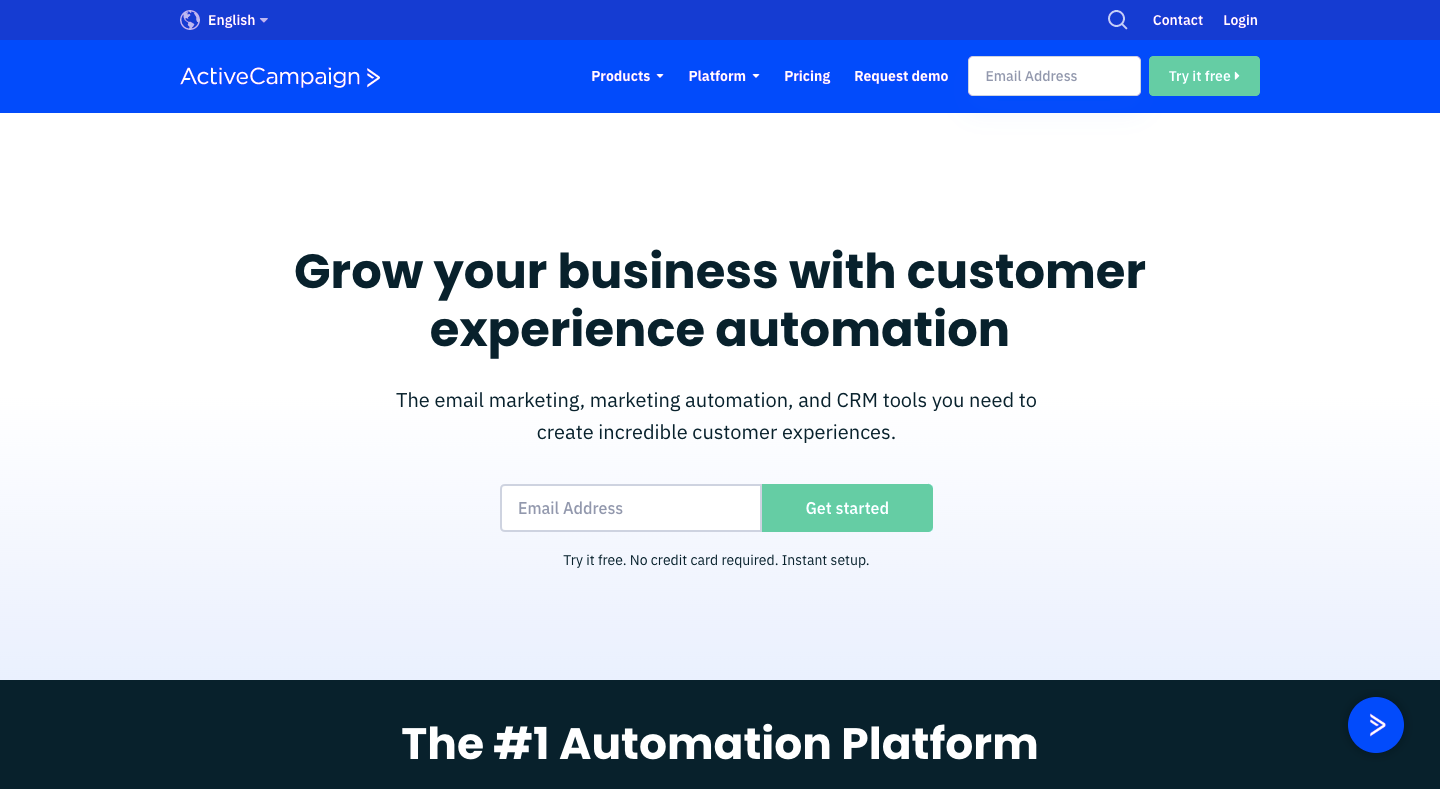 ActiveCampaign is another all-round marketing automation platform, but its wealth of features adapt to the needs of marketers in a diverse range of niches. It’s one of the more expensive tools in our roundup of ConvertKit alternatives, which might put it beyond the reach of some content creators. But if you need heavyweight automation functionality, ActiveCampaign is a real contender.
ActiveCampaign is another all-round marketing automation platform, but its wealth of features adapt to the needs of marketers in a diverse range of niches. It’s one of the more expensive tools in our roundup of ConvertKit alternatives, which might put it beyond the reach of some content creators. But if you need heavyweight automation functionality, ActiveCampaign is a real contender.
What Makes ActiveCampaign the Best ConvertKit Alternative?
- Predictive action-based optimization. With ActiveCampaign, you can optimize campaigns based on machine learning-driven predictive actions (such as optimizing email send times around when they’re most likely to be opened). ConvertKit doesn’t do this.
- More (and higher-quality) email templates. ConvertKit offers a couple dozen professionally designed templates. But ActiveCampaign has over 150—and, for the most part, they look more professional.
- Integrate with everything. ConvertKit integrates with about 120 third-party tools (and thousands more through Zapier), but it can’t compete with ActiveCampaign, which has 870+ native integrations.
- Advanced automations. ConvertKit’s automation builder is simple to use, but it’s more limited than ActiveCampaign, which delivers automatic behavior-based segmentation, abandoned cart recovery campaigns, order- and event-triggered follow-ups, and more.
- Insightful reporting. If you need to access anything more than basic email engagement metrics, ConvertKit’s not the platform for you. ActiveCampaign, by contrast, provides a whole world of insights, from real-time order data to tracked shopper activity across all touchpoints in the user journey.
How Does ActiveCampaign Compare to ConvertKit?
| ActiveCampaign | ConvertKit | |
| Best Feature | Predictive actions use machine learning to deliver customer experiences based on data, such as the best time to send emails. | Integrated newsletter referral program helps creators grow their reach by leveraging their existing audience. |
| Best For | Advanced marketers who need high-level automation | Content creators |
| Pros | Advanced automations and reporting. | Generous free plan. |
| Cons | No free plan; generally more expensive (but with a ton of extra features). | Can’t compete with ActiveCampaign’s advanced insights and automations. |
| Pricing/Month | From $29 per month for one user and unlimited emails. | Free for up to 1,000 subscribers and unlimited email sends; paid plans start at $9 per month for up to 300 subscribers and unlimited sends. |
| Support | All ActiveCampaign plans offer 24/7 email and chat-based support, but only Enterprise customers get over-the-phone support. | Paying customers get live chat and email support, with priority access offered to Creator Pro subscribers. Free subscribers only get community support. |
8. AWeber
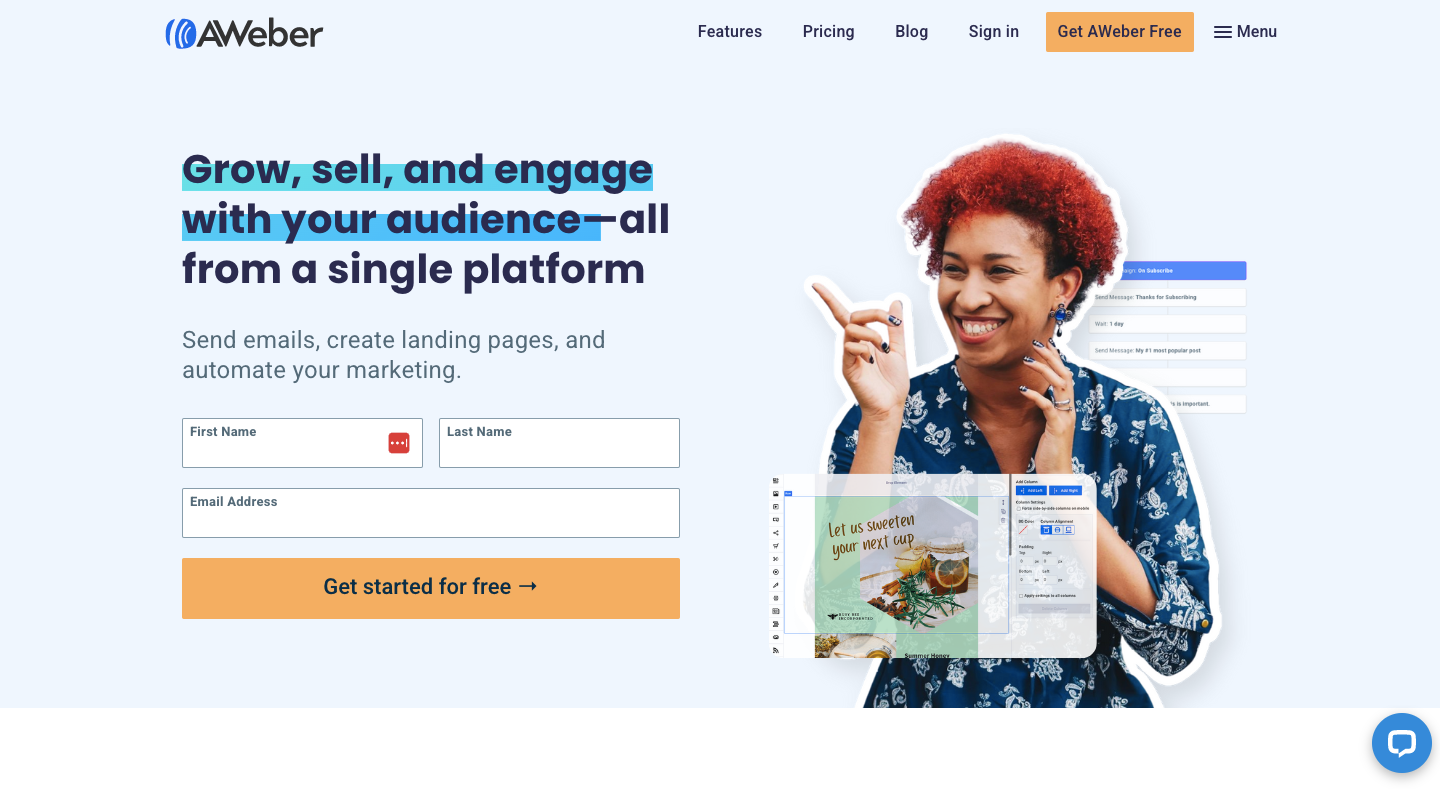 AWeber used to be a low-cost, no-frills email marketing platform, but it’s added a ton of premium features in recent years to help it compete with the likes of ActiveCampaign and GetResponse. As one of the cheaper tools on the market, it’s traditionally proved popular with solopreneurs and content creators, but is it better than ConvertKit?
AWeber used to be a low-cost, no-frills email marketing platform, but it’s added a ton of premium features in recent years to help it compete with the likes of ActiveCampaign and GetResponse. As one of the cheaper tools on the market, it’s traditionally proved popular with solopreneurs and content creators, but is it better than ConvertKit?
What Makes AWeber the Best ConvertKit Alternative?
- Buy and connect domains. With AWeber, you can buy a website domain and set it up without ever leaving the platform. ConvertKit doesn’t do that (although it does offer a handy landing page builder).
- Integrate with more tools. AWeber offers a bunch more integrations than ConvertKit (750+ vs. about 120). And it integrates with Google Analytics, whereas ConvertKit doesn’t.
- Phone-based support. Unlike a lot of marketing tools, AWeber lets you pick up the phone to reach its support team—even if you’re only on its free plan. ConvertKit only offers live chat and email support (but you only get community support through the free plan).
- More comms channels. As well as sending emails, AWeber lets you reach your audience through push notification campaigns. Even free users can send web push notifications to up to 50,000 subscribers. You’ll need an integration to send push campaigns through ConvertKit.
- Build custom email templates in seconds. One of AWeber’s most interesting features is its smart designer, which automatically creates email templates based on your website or Facebook page URL. ConvertKit doesn’t do this (although it does offer a decent library of email templates).
How Does AWeber Compare to ConvertKit?
| AWeber | ConvertKit | |
| Best Feature | Create email templates in seconds using your website or Facebook page URL. | Integrated newsletter referral program helps creators grow their reach by leveraging their existing audience. |
| Best For | Startups and small businesses | Content creators |
| Pros | Lots of useful extras, like push notifications and a smart template builder. | More generous free plan; built-in tools for newsletter growth and monetization. |
| Cons | Lacks ConvertKit’s creator-specific functionality. | Only lets you reach your audience via email. |
| Pricing/Month | Free for up to 500 email subscribers and 3,000 monthly email sends; paid plans priced from $12.50 per month for up to 500 subscribers and unlimited emails. | Free for up to 1,000 subscribers and unlimited email sends; paid plans start at $9 per month for up to 300 subscribers and unlimited sends. |
| Support | All users—even free subscribers—can access 24/7 live support via phone, email, and chat (although paying customers are placed in a priority queue). | Paying customers get live chat and email support, with priority access offered to Creator Pro subscribers. Free subscribers only get community support. |
9. Constant Contact
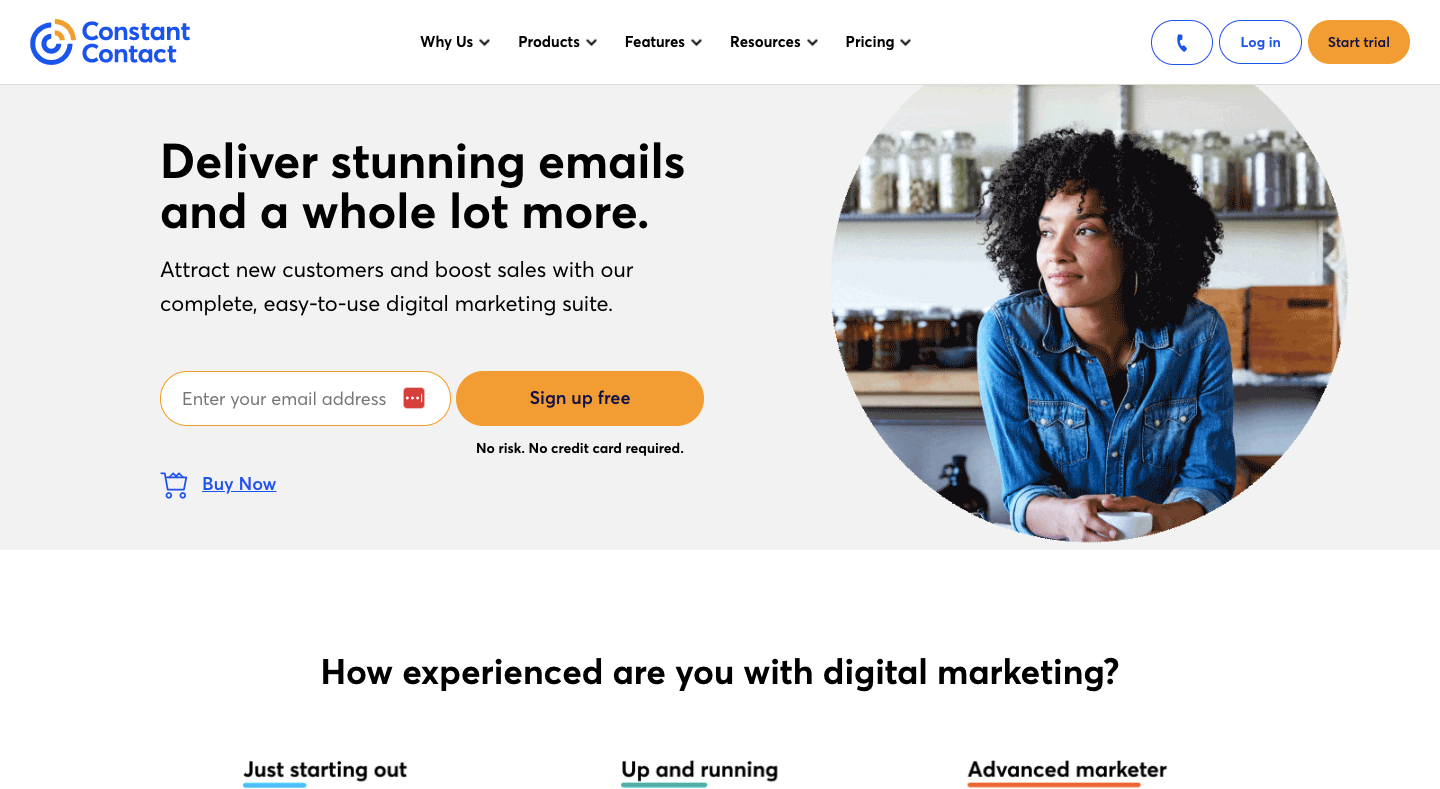 At first glance, Constant Contact is just like AWeber: both are traditional email marketing tools that have recently bolted on a bunch of extra features. Even their websites look kind of similar. But how does Constant Contact measure up against ConvertKit?
At first glance, Constant Contact is just like AWeber: both are traditional email marketing tools that have recently bolted on a bunch of extra features. Even their websites look kind of similar. But how does Constant Contact measure up against ConvertKit?
What Makes Constant Contact the Best ConvertKit Alternative?
- In-platform social scheduling. Constant Contact is one of relatively few email marketing tools to offer built-in organic social scheduling and ad management. You can’t do this through ConvertKit.
- Built-in event marketing. Perhaps Constant Contact’s most interesting feature (for some users, at least) is its inclusive event marketing functionality, which allows users to create registration forms, send invites via email, sell tickets, and more. ConvertKit doesn’t do this, although it does integrate with event management and ticketing platform Eventbrite.
- Phone-based customer support. All Constant Contact customers can access phone-based customer support, whereas ConvertKit only offers support through live chat and email (and if you’re a free user, you’ll have to make do with community support).
- More advanced reporting. We don’t want to sound like a broken record, but honestly, ConvertKit’s reporting is pretty limited. Constant Contact is much better here, offering useful data and insights like click segmentation and click-tracking heat maps. You can even access reports on the go through the Constant Contact app.
- Discounts for nonprofits. With Constant Contact, nonprofits and charities can save up to 30 percent on standard prices. ConvertKit doesn’t offer any such discount.
How Does Constant Contact Compare to ConvertKit?
| Constant Contact | ConvertKit | |
| Best Feature | Manage campaigns on the go from a dedicated mobile app. | Integrated newsletter referral program helps creators grow their reach by leveraging their existing audience. |
| Best For | Nonprofits and charities (they save up to 30 percent on standard Constant Contact prices) | Content creators |
| Pros | Built-in social media and event management tools. | Has an (extremely generous) free plan and built-in newsletter monetization tools. |
| Cons | Expensive prices for a comparatively limited feature set; no free plan. | Limited reporting; no social scheduling tools. |
| Pricing/Month | From $12 per month for up to 500 contacts and 5,000 monthly email sends. | Free for up to 1,000 subscribers and unlimited email sends; paid plans start at $9 per month for up to 300 subscribers and unlimited sends. |
| Support | All plans offer live chat and phone support, while Standard and Premium customers get onboarding calls too. | Paying customers get live chat and email support, with priority access offered to Creator Pro subscribers. Free subscribers only get community support. |
10. HubSpot
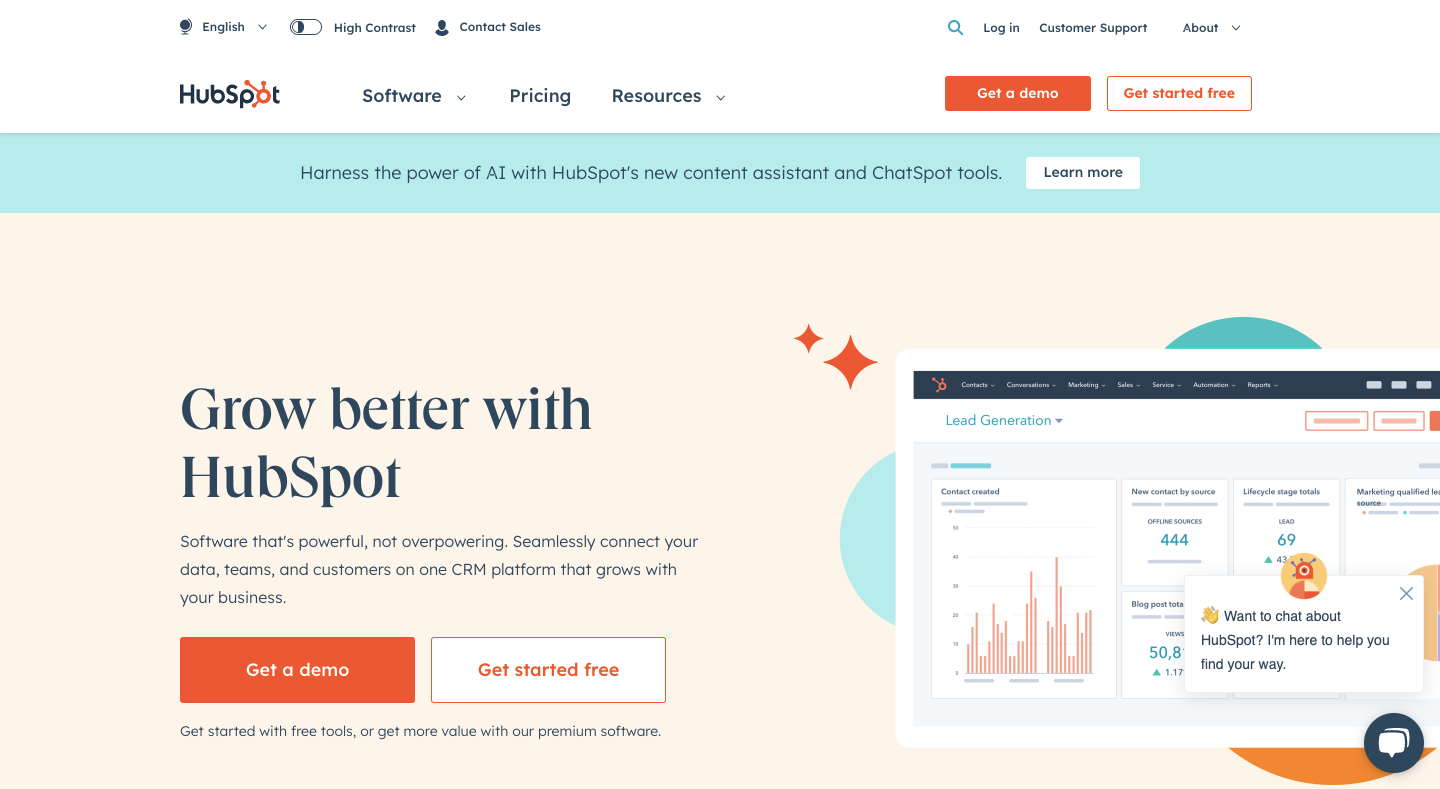 HubSpot and ConvertKit are like chalk and cheese: HubSpot is an enterprise-grade sales and marketing platform, whereas ConvertKit is aimed at individual creators. However, HubSpot does offer a wealth of lower-cost functionality. So is it a viable ConvertKit alternative?
HubSpot and ConvertKit are like chalk and cheese: HubSpot is an enterprise-grade sales and marketing platform, whereas ConvertKit is aimed at individual creators. However, HubSpot does offer a wealth of lower-cost functionality. So is it a viable ConvertKit alternative?
What Makes HubSpot the Best ConvertKit Alternative?
- Wide-ranging free plan. Sure, it’s not the cheapest tool on the market, but HubSpot does offer an intriguing free plan that incorporates some of the platform’s superb automation and segmentation features. ConvertKit’s free tier offers more contacts and email sends, but it doesn’t include marketing automation.
- Superb CRM (and it’s free). HubSpot has built one of the best CRMs on the market—and it’s available free of charge. ConvertKit doesn’t offer a CRM, although it integrates with JetpackCRM and Monday.com.
- Powerful (yet accessible) analytics. There’s really no comparison here. HubSpot offers some of the most advanced reporting and analytics tools of any email platform, acting as a single source of truth for all your marketing, sales, and service data. By contrast, ConvertKit only provides basic email engagement metrics.
- More integrations than you could ever need. HubSpot has 1,000+ native integrations—almost 10 times as many as ConvertKit.
How Does HubSpot Compare to ConvertKit?
| HubSpot | ConvertKit | |
| Best Feature | Connect marketing, sales, content management, and customer service in a single platform. | Integrated newsletter referral program helps creators grow their reach by leveraging their existing audience. |
| Best For | B2B inbound marketing | Content creators |
| Pros | Far more advanced reporting, segmentation, and automation; free CRM. | Cheaper if you just want to send high volumes of emails to a small marketing list. |
| Cons | Pretty expensive, especially if you’re just looking for an email tool. | Only offers a fraction of HubSpot’s functionality. |
| Pricing/Month | Free marketing plan includes unlimited contacts and 2,000 monthly email sends. Paid marketing plans start at $18 per month for 1,000 contacts and 5,000 monthly sends. | Free for up to 1,000 subscribers and unlimited email sends; paid plans start at $9 per month for up to 300 subscribers and unlimited sends. |
| Support | Paying customers can get 1:1 email and in-app chat support. Phone support is available at Pro level and above. | Paying customers get live chat and email support, with priority access offered to Creator Pro subscribers. Free subscribers only get community support. |
Frequently Asked Questions
In a word: yes! ConvertKit is a superb platform for content creators who just want to send emails. But lots of other tools provide greater functionality. If you’re looking to sell products through your newsletters, you’re better off with an ecommerce-friendly platform like Drip. And if ConvertKit’s reporting is too basic for you, opt for a strong all-rounder like Mailchimp or Brevo.
Google doesn’t offer a dedicated ConvertKit alternative, but it’s possible to turn Gmail into a basic email marketing tool using a third-party plugin.
ConvertKit is the best email software for some content creators—predominantly those with small marketing lists and basic reporting needs. If you have more than 1,000 contacts and crave more detailed reports, ConvertKit isn’t right for you.
ConvertKit’s biggest disadvantage is its reporting, which only offers basic email engagement metrics (like open and click-through rates). That might be fine for some content creators, but if you want to understand how different audiences interact with your emails—and what happens beyond the inbox—you’ll find ConvertKit too limited. Also, while ConvertKit offers one of the best free plans on the market, it gets pretty expensive when you need to upgrade to a paid subscription.

Conclusion
If you’re just getting started as a content creator or only have a small email list (i.e. no more than 1,000 contacts), ConvertKit is the perfect platform for you.
But don’t be surprised if you outgrow it, fast.
When that happens, you’ll need a platform with sophisticated audience segmentation and automations, in-depth reports, and the ability to track every last cent generated by your email campaigns.
Drip is exactly that platform.
Best of all, our intuitive user interface makes it simple for content creators to leverage our more advanced features.
But don’t take our word for it. See for yourself by signing up for your 14-day free trial today!
